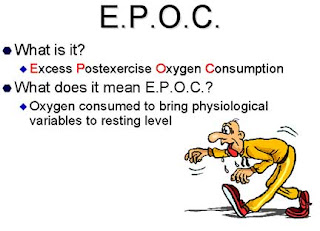 Introduction
IntroductionAfter cardiovascular exercise or weight training, the body continues to need oxygen at a higher rate than before the exercise began. This sustained oxygen consumption is known as excess postexercise oxygen consumption (EPOC). Originally referred to as an oxygen debt, this postexercise state was first hypothesized by A.V. Hill and H. Lupton in 1922. Hill and Lupton theorized that the body needs to replace the oxygen used by working muscles during mild to intense bouts of exercise. More recently, researchers have used the term EPOC to describe the several different events that occur as the body restores itself to homeostasis, or rest.
This article will describe the physiological factors that contribute to EPOC and discuss its relation to weight management.
EPOC Overview
Body: During EPOC the body is restoring itself to its pre-exercise state, and thus is consuming oxygen at an elevated rate. This means that energy is also being expended at an elevated rate.
The following occurs during EPOC:
1) Replenishment of Energy Resources: Replenishment occurs for the immediate source of energy, known as the phosphagen system, which is comprised of creatine phosphate and ATP (adenosine triphosphate). In addition, lactate, a molecule that is produced during more intense exercise, is being converted to pyruvate for fuel utilization. The body is also restoring the muscle glycogen (a stored form of glucose) that has been used during the exercise bout.
2) Re-oxygenation of Blood and Restoration of Circulatory Hormones: During exercise metabolism, large amounts of oxygen are used to break down food substrates for energy. Therefore, the body continues to expend energy after exercise to re-oxygenate the blood. In addition, in the postexercise period, the body restores the levels of circulatory hormones, which increased during exercise, to normal.
3) Decrease in Body Temperature: As energy is liberated from the exercising muscle tissues of the body, heat is produced. Thus, during EPOC, the body must expend energy to return to the normal core body temperature.
4) Return to Normal Ventilation and Heart Rate: Energy expenditure is greatly elevated as the body rapidly returns to a normal breathing rate. Heart rate is also returning to a pre-exercise rate.
EPOC and Weight Management
Because the body continues to expend energy after exercise, EPOC plays a supplemental role to an exercise program in weight management. Currently, researchers are interested in the effect different forms of exercise have on EPOC.
The evidence suggests that a high-intensity, intermittent-type of training (interval training) has a more pronounced effect on EPOC (Haltom et al. 1999). Also, it appears that resistance training produces greater EPOC responses than aerobic exercise (Burleson et al. 1998). The research suggests that high-intensity resistance exercise disturbs the body’s homeostasis to a greater degree than aerobic exercise. The result is a larger energy requirement after exercise to restore the body’s systems to normal (Burleson et al. 1998), and thus an explanation for the higher EPOC.

2 comments:
Hi King Spartan!
Awesome article, didn't even know that happened! i always feel dehydrated and sore!!
Feeling good today!
Nike Basketball shoes
Nike Outlet
LeBron James Shoes
Post a Comment